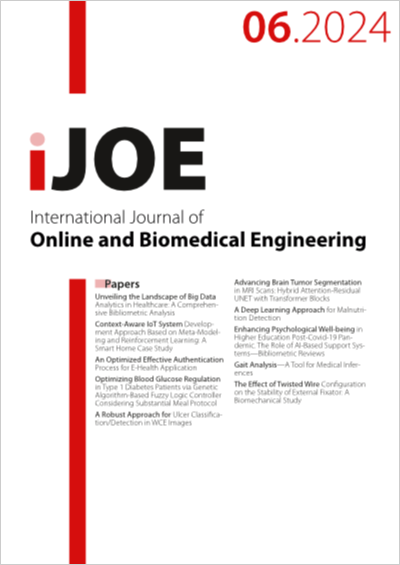A Deep Learning Approach for Malnutrition Detection
DOI:
https://doi.org/10.3991/ijoe.v20i06.46919Keywords:
Good Health and Well-being, Deep Learning, ResNet-18, MalnutritionAbstract
The timely detection of malnutrition in children is of paramount importance, as it allows for early intervention and treatment. This proactive approach not only prevents further health deterioration but also fosters proper growth, minimizing the long-term consequences of malnutrition, such as stunted growth, impaired cognitive development, and increased vulnerability to diseases. Our work encompasses the creation of a new dataset comprising images of children in Healthy, Undernourished, Stunting, and Wasting categories. The core objective is to assess the deep learning model performance in classifying these children images. The experimentation is carried out by varying epochs, batch size, optimizers AdamW, Adamax, and RMSprop; and different values of the learning rate 0.1, 0.01, 0.001, and 0.0001 during model training. The model is trained on image dataset constructed by cleaning images generated by the stable diffusion model. The model is tested on randomly selected child images from websites. The model successfully classified two classes with 95% accuracy, 97.6% F1 score, precision 97.6%, and 97.6% recall with Adam optimizers, 0.0001 learning rate, and Batch size 4. Additionally, for the four-class categorization scenario, the study broadens the classification. The model achieved 88.87% accuracy, 90.3% recall, 90.2% precision, and an F1 score of 90% for four-class categorization with AdamW optimization, 0.0001 learning rate, and batch size 6. These results are satisfactory for prediction of malnutrition category in children.
Downloads
Published
How to Cite
Issue
Section
License
Copyright (c) 2024 Shilpa Ankalaki, Dr. Vidyadevi G Biradar, Kishore Kumar Naik, Dr. Geetabai S Hukkeri

This work is licensed under a Creative Commons Attribution 4.0 International License.


